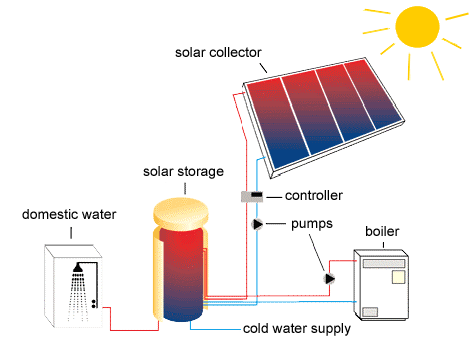
Domestic hot water
In Germany the demand of hot drinking water with a temperature of 60°C amounts to about 30 litres per day and person averaged, corresponding to an available heat of 1.8 kilowatt-hours per year and person (1.8 kWh/(a p)). This value varies between approximately 10 and 100 litres / (a p) depending on demands in comfort and quality of life. The main part is used for personal hygiene (shower, bath tub) and moreover for further cleaning tasks (e.g. doing the dishes and washing clothes).
The hot water supply should be constructed in a manner that the desired adjustable temperature and quantity of hot water is provided without a great time delay. The water has to be hygienically perfect and the system should work safe, environmentally friendly, energy-saving and cost-effective.
Drinking water is not germ-free, though being of high quality. Water heated up to 30°C - 45°C, which means perfect conditions for micro-organism, bacteria like "legionella" can multiply with a high frequency and become dangerous to health. This can be counteracted by temporarily heating up the whole hot water supply over 60°C - 65°C. Care has to be taken, that also the circulating water in the conduit pipes has to be heated up in the same way. Alternatively special UV radiation-tools which kill the bacteria can be installed.
The temperature of the hot-water-system should not exceed 60°C all the time because of the danger of corrosion and the increasing risks of calcination by sedimentation of carbonate with increasing temperature. Furthermore a lower water temperature reduces the heat loss of the system. Temperatures below 60°C exclude the danger of scalding to a great extend.
Systems for instantaneous water heaters are characterised by different point of views:
Centralised systems
Centralised systems are usually using the same heat sources as the heating installation. These systems can make use of nearly all energy resources. Particularly a solar support can be easily integrated. Storage-systems are normally used with centralised instantaneous water heaters designed to meet peak demands. Today mostly circulation-lines are installed if the distance between storage and energy source cannot be kept short. They prevent a long water intake at the tapping point by making hot water permanently available. The heating up to over 60°C in all parts of the lines can only be guaranteed by using water-circulation lines and a (time-controlled) circulation pump. The heat losses in the storage space and in the hot water supply are quite high but they can be reduced by good insulation of the pipes and a time-controlled water-circulation adapted to the requirements. In summer and periods between seasons when the heating system is supplying water for domestic use only, the boiler degree of utilisation in elderly boilers is far below the values which are reached during heating service.
Solar supported centralised hot water supply
The unfavourable summer service of central heating can be avoided by solar supported centralised hot water supplies. Therefore already little collector surfaces with about 1 m² to 2 m² per person are sufficient to deliver enough thermal energy needed for the hot water supply in summer to cover 80 % - 100 % of the demand and in winter up to 40 %. The heat is transported from the collectors into a thermal hot water storage. This storage will be recharged by the conventional boiler during periods of insufficient solar radiation.
 |
| Figure 1: Scheme of a thermal solar system for support of a centralised domestic hot water system [http://www.solarfoerderung.de/solar/fakten.cfm] |
With installation costs of 500 € to 2,000 € per m² collector surface solar supported hot water systems even are economical for Middle-Europe. For smaller systems, which do not have to provide full coverage (up to 20 m², physical life 20 years), the overall costs per kWh amount to 0.13 € and 0.50 €.
Decentralised systems
The advantage of a decentralised supply with instantaneous heaters are short lines between heating source and tapping point. So it is much easier to install the water system because only one cold water supply has to be built. On these short distances between heating source and tapping point circulation lines and isolation of pipes are mostly not necessary. Heat losses in storage or in the pipes are insignificant. Therefore individual heating units at all tapping points are required which are connected to gas or high voltage current. There are no hygienic problems caused by the accelerated growth of bacteria because the water is only heated up before usage. Integration of solar water heating with decentralised supply is not really possible. Energy generation can be made by gas or electrical current units only.
Dishwashers and washing machines are supplied with their own water heating elements which heat up cold drinking water with electricity. For using efficient and environmentally friendly systems (gas, district heat or centralised fuel heating) these devices should be connected directly to hot water lines. By this means the waste of electricity descents and very often the duration of washing is reduced.
Literature
[1] Ladener, H.; Späte, F., "Solaranlagen: Handbuch der thermischen Solarenergienutzung", Ökobuchverlag, 6. Auflage, Staufen, 1999.
[2] E.R. Schramek, "Taschenbuch für Heizung + Klimatechnik", 70. Auflage, Oldenbourg Industrieverlag, München, 2001.
[3] RWE Energie AG, "RWE-Bauhandbuch", Energie-Verlag-GmbH, Heidelberg, ISBN 3-87200-700-9, 12. Ausgabe, 1998.